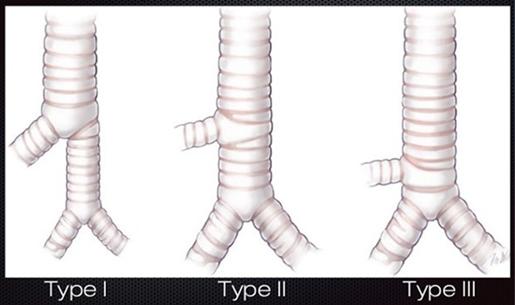(bronchia suis)
This anomaly is present in 0.1 to 5% of the population. It is more common in cases of trisomy 21, esophageal atresia, heterotaxy and other tracheal anomalies (stenosis or tracheomalacia).
Prevalence: 0.1 to 2% on the right side and 0.3 to 1% on the left. Aberrant and supernumerary bronchus which originates from the lower half of the trachea, above the carina.
Conacher's classification:
- type I: the bronchus is located more than 2 cm above the carina, with a narrowing of the distal portion of the trachea (complete tracheal rings ): in that case, the tracheal bronchus originates at an angle of about 30° with the trachea and is often wider than it. Often referred to as "false carina" (diagnosis: bronchoscopy or chest CT scan). Cases of bilateral tracheal bronchi, each connected to the ipsilateral upper lobe, have been described.
- type II: the bronchus is located more than 2 cm above the carina without modification of the tracheal size
- type III: the tracheal bronchus originates nearby or even at the level of the carina; trifurcation of the carina is a form of tracheal bronchus.

The tracheal bronchus originates more often on the right side and is then connected to the upper right lobe or to a
supernumerary lobe. Sometimes the tracheal bronchus consists in a kind of long diverticulum, not connected to any pulmonary tissue. Bilateral tracheal bronchus cases have been described mainly in case of asplenia.
The malformation is generally asymptomatic but can cause recurrent atelectasis, pneumonia, stridor or wheezing (when associated with tracheal stenosis).
Anesthetic implications:
this is a possible cause of intraoperative hypoxemia or postoperative atelectasis when the endotracheal tube blocks the tracheal bronchus. Care must be taken to intubate the trachea above the origin of the tracheal bronchus. The presence of a tracheal bronchus may be a (rare) cause of difficult ventilation after intubation, if the endotracheal tube enters the abnormal bronchus, whether it is or not connected to pulmonary tissue.When needed single-lung ventilation can reveal complex to achieve: this could need to combine a double lumen endotracheal tube and a bronchial blocker.
References :
- Conacher ID.
Implications of tracheal bronchus for adult anaesthetic practice.
Br J Anaesth 2000 ; 85 : 317-20. - Wiser SH, Hartgan PM.
Case report: challenging lung isolation secondary to aberrant tracheobronchial anatomy.
Anesth Analg 2011; 112:688-92. - DelPizzo KR, Joffe DC, Finkel JC.
Tracheal bronchus in a 10-month-old patient for thoracoscopic resection of congenital cystic adenomatoid malformation.
Pediatr Anesth 2006; 16: 997-8. - Verghese S, Jensen G, Ratnayaka K, Kanter J.
A fluoroscopic diagnosis of bronchus suis or porcine bronchus to explain hypoxemia during anesthesia.
Anesth Analg 2008; 107: 1445. - Giral T, Marandon J-Y, Fischler M.
Ventilation unipulmonaire chez une patiente présentant une trifurcation bronchique.
Ann Fr Anesth Réanim 2014 ; 33 : 272-4. - Rahmanian R, Zheng J, Chadha NK, Kozak FK, Campbell AIM, Ludemann JP.
False carina : a distinct variant of tracheal bronchus.
Int J Pediatr Otorhinolar 2015 ; 79 : 623-8 - Wong F, Detterbeck F, Kurup V.
Images in Anesthesiology: airway management in patients with tracheal bronchus.
Anesthesiology 2016; 125: 395 - Hasham F, van Helmond N, Sidlow R.
Anaesthesia aand orphan disease: Difficult ventilation following intubation in Goldenhar syndrome.
Eur J Anaesthesiol 2017; 34: 181-3 - Jain D, Bhardwaj N, Pareek A, Parikh B.
The tracheal bronchus: an unusual cause of difficult ventilation.
Can J Anesth 2017; 64: 979-80. - Machovec KA, Greene NH, Raynor EM, Taicher BM.
Bilateral upper lobe bronchi originating from the trachea.
Anesthesiology 2017; 127: 1015
Updated: November 2019